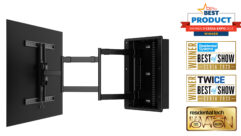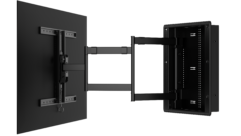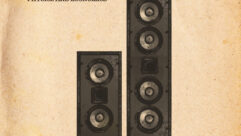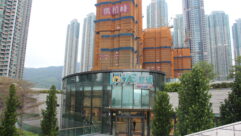In-Wall Speakers
Aug 1, 2003 12:00 PM,
Chris Steinwand
Contemporary in-wall loudspeaker systems are generally intended for custom installation. Dozens of loudspeaker manufacturers that offer products ranging in application from installed sound to consumer audio to studio monitoring have an in-wall product in their line, as well, and the future is going to bring only more developments. The primary benefits of in-wall loudspeaker systems are that they don’t take up any floor space and they’re easy to conceal. However, the term in-wall is misleading, because these systems can be placed almost anywhere across a flat surface. This includes ceilings and floors, which makes them all the more easy to camouflage. Because of this, in-wall speakers are particularly well suited to multiroom audio systems and are often used to provide background music in environments where floor-standing systems would be an obstruction and a distraction. In-wall speakers are also commonly applied in home-theater surround systems.
Most in-wall speakers use the cavity in the wall that exists between two studs as their enclosure. They are typically attached by special screws in the baffle to the drywall (or other wall surface), to a nearby stud, or to a special frame attached to the studs. The speaker components are typically attached to a front baffle that is connected to the frame or wall.
Though the use of in-wall speakers is often convenient from an architectural point of view, the speakers generally do not perform as well as their out-of-wall counterparts. There are a few reasons for that. No matter how well anchored to the wall the speaker is, the wall structure does not provide a solid, resonant-free enclosure. Many manufacturers combat that problem by mounting the in-wall speaker in its own enclosure, which fits into the wall cavity so that you are effectively mounting a speaker cabinet in the wall. Although that approach can produce an improvement, you are still attaching the enclosure to a wall. The amount of energy transfer from the transducer to the wall can be reduced but never completely eliminated. This energy transfer greatly affects lower frequencies. As the wall vibrates, it is taking energy away from the transducers. A wall or the chamber of a wall that the speaker resides in can also have a resonant frequency that can produce cancellation of up to 10 dB in a very narrow bandwidth.
DIFFRACTION ACTION
Another factor that affects in-wall speakers is called diffraction or diffraction loss. That occurs in the low-frequency range of loudspeakers in enclosures that are located in the open, away from walls or flushmounted to broad surfaces, such as a wall. At high frequencies, the speaker is radiating into half space; that is it’s radiating only into the forward hemisphere. No significant energy is radiated to the rear of the speaker. At low frequencies, the speaker is radiating into both the forward hemisphere and the rear hemisphere. In other words, at low frequencies, the speaker radiates into full space. Because the energy density in the front hemisphere at low frequencies is reduced, there is a loss of bass. Speaker systems designed for radiation into half space (mounted flush on an infinite plane) exhibit a loss of bass when implemented in typical speaker enclosures. Fortunately, this bass loss can be accurately modeled and subsequently compensated.
Most loudspeaker modeling is performed based on the assumption of radiation into half space. A speaker radiating into half space plays 6 dB louder than the same speaker radiating into full space. That is the crux of the diffraction loss. A full-range speaker finds itself radiating into half space at the upper frequencies but radiating into full space at lower frequencies. As a result, there is a gradual shift of -6 dB from the highs to the lows. This is what is called the 6 dB baffle step or the enclosure’s diffraction loss. The center frequency of the transition is dependent on the dimensions of the baffle. The smaller the baffle, the higher the transition frequency. Because the wall surface is usually quite large, the center point is typically low, which further exacerbates the lack of bass challenge that in-wall speakers face. To put the -6 dB rule into perspective, consider that it takes four times the amplifier power to produce a 6 dB gain. So if all your components had equal sensitivity and impedance and your woofer were receiving 100W of power, your midrange and tweeter would be receiving 400W. Because impedance drops in a linear fashion as frequency drops, this is not a practical comparison, but it is mathematically correct, and it serves to illustrate the extent of effect diffraction can have on an in-wall audio system.
Even though diffraction primarily affects the lower frequencies, in a wallmounted situation, all frequencies are affected to a degree. Although higher frequencies are more directional than lower frequencies and while there are ways to increase directionality overall, the fact is all audible frequencies are omnidirectional to some degree.
The main advantage of using in-wall speakers is their flexibility of placement. Traditionally, that has been the primary factor in deciding where to put them. But as the fidelity of these speakers improves and as listeners become more discerning, imaging and overall sound quality are increasingly important considerations. In most cases, a compromise is necessary. If you’re doing a home theater or surround-sound room, ideally, the speakers would be at ear level with the listener. But few people are the same height, so an average is the best that can be hoped for.
Some installers are also tempted to place in-wall speakers in corners or near ceilings. This should be avoided when possible because of the increased diffraction, the phase cancellation, and the dreaded standing wave, which can be the worst of the three. Though standing waves are not typically a serious problem in low sound-pressure environments, they have the potential to wreak havoc with your system’s frequency response and should be avoided like the plague.
Because of their placement in wall cavities and the desire to make in-wall speakers as unobtrusive as possible, most are similar in size to bookshelf speakers. They tend to be under a foot to 18 inches wide and are typically between one and two feet tall, though there are notable exceptions to this formula. Most in-walls feature limited bass capabilities owing to application constraints and are frequently augmented with subwoofers.
I’ve selected a few companies to highlight in order to help you gain a perspective of what is available. The companies and products I mention here are not meant to be a complete list — far from it. There are literally hundreds of models from dozens of manufacturers offering some high-quality in-wall speaker solutions.
IN-WALL MANUFACTURERS
Here’s a look at just a few of the in-wall speaker manufacturers.
Peavey Architectural Acoustics has a wide range of products, ranging from input to output (mics to speakers). Its contribution to the in-wall speaker market is the WS 802 and the WS 502. The WS 802 incorporates an 8-inch polypropylene woofer and a 1-inch soft dome tweeter. Frequency response is 58 Hz to 18 kHz, and the front grille measures approximately 14 inches high by 10 inches wide. The WS 502 has a 5¼-inch woofer and a 1-inch dome tweeter. Both models are also offered in a 70V version.
Sonance has been making in-wall speakers for more than 20 years. It offers more than seven series of in-wall speakers to meet a variety of applications. The company’s C Series is a weather-resistant 6½-inch polypropylene woofer with either a fixed 1½-inch cloth dome tweeter or a ½-inch swiveling soft dome tweeter.
The M Series is the company’s economy line and features a compact footprint or “wallprint” and incorporates a 4-inch driver either on its own or paired with a fixed or swiveling tweeter.
The Cinema Series, as the name implies, is designed for home-theater listening. All models in this series meet THX surround-sound requirements, and the more expensive models feature bipole/dipole components.
The Silhouette Series is a tall and slim design incorporating 6-by-9-inch drivers for the low end and facilitating the slim profile.
Sonance has a few other series that extend into the high-end consumer market, as well, which gives them a product mix that covers a wide range of applications.
Tannoy‘s offerings are based on bookshelf and floor-standing versions of its product line. The M2iw is a two-way system with a 6½-inch midbass driver and a 1-inch soft dome tweeter. The front baffle measures 15 inches high by 10½ inches wide. Frequency response is from 65 Hz to 20 kHz. The S8iw incorporates Tannoy’s Dual Concentric technology with an 8-inch constant directivity driver and integral crossover network. This technology is well known within the recording industry for its phase coherent, point source abilities. Frequency response for the S8iw is 47 Hz to 20 kHz.
Niles Audio has long been at the forefront of multiroom audio and, as such, has an impressive compliment of in-wall products. Its HD group of loudspeakers offers superior sound quality and durability, using advanced components and circuitry. These speakers excel as primary speakers and for home-theater applications. Their weather-resistant construction also makes them ideal for moist environments.
The Advanced Technology series incorporates new and distinct technologies designed to help reduce in-wall vibration and tweeter diffraction. As with the other companies mentioned here, its Web site offers a wealth of in-depth and technical information on each product.
SpeakerCraft, which claims to be the inventor of in-wall speakers, has an impressive selection. While most in-wall speakers fit a certain profile, every once in awhile, there is an exception. In this case, it’s the Rogue from SpeakerCraft. These speakers are 7 feet tall and designed to fit into a 16-inch stud bay, with a depth of just 3½ inches.
The cabinet is fabricated of a sound-absorbing ultradense compound with a handcrafted rosewood burl finish. It houses eight 5¼-inch magnesium aluminum alloy cones contained in a multiridged alloy basket (featuring a smooth inverted aluminum alloy surface) and is magnetically shielded. In addition, the cabinet contains a six-foot-long magnetic planar line source ribbon transducer, which delivers unsurpassed horizontal dispersion.
All of these components are mounted on a ½-inch CNC milled solid aluminum faceplate. The plate is then powder coated and polished to a mirror image. Grilles (if desired) can be fabricated from virtually any material color and shape at the buyer’s request.
An electronic crossover is used to create a seamless, delicate blend across the entire frequency range. The controller is fully adjustable to match your listening-room acoustics.
Miller and Kreisel (M&K) also offers an in-wall version of one of its popular studio monitors. Based on the M&K 150 series, the SW-150 series is available as a balanced left and right design, with either side being suitable for use as a center channel. Its most compact in-wall speaker package has a grille size of only 8.9 inches by 7.3 inches to take up an absolute minimum of wall space. Based on the SW-50, it has the identical platform — with the same baffle, drivers, and Phase-Focused Crossover — to deliver the same exceptional sound quality. The company also offers several models in between, many of which are directly based on their monitors, which are legendary in the recording industry.
Martin Sound has a new MS HOME in-wall speaker line that offers excellent sound reproduction at a lower price. The poly cone woofer on both the 6½-inch and 8-inch and the 1-inch textile tweeter are controlled with a 12 db — per — octave crossover. The speakers are also weather resistant. Both models feature the up-to-date flip-out mounting tabs for easy installation. Preconstruction brackets are also available for new construction prewires.
Bose features the Virtually Invisible 191, with either round or rectangular interchangeable grilles. A proprietary enclosure technology helps ensure consistent performance regardless of the wall surface. Each speaker has two 2½-inch full-range drivers in an Articulated Array design and are magnetically shielded, as well.
The trend of using in-wall (and on-wall) loudspeakers is on the rise. As multiroom audio and home automation markets continue to grow, so will the product offerings. Recent technological developments are also helping to increase the fidelity of in-wall units. Consumer awareness is also on the rise. This means that consumers are demanding better quality sound and innovative ways to deliver it. This is good news for the system integrator, because the consumers depend on us to know how to achieve their audio goals.
Chris Steinwandis a marketing veteran of the pro audio/video industry, a freelance writer, and the director of Stonejam Consulting. He can be reached at[email protected].
For More Information
Australian Monitor
www.australianmonitor.com
Ž 201
Bose
www.bose.com
Ž 202
Bowers and Wilkins
www.bwspeakers.com
Ž 203
CSi/SPECO
www.csi-speco.com
Ž 204
DCM Loudspeakers
www.dcmspeakers.com
Ž 205
Elan Home Systems
www.elanhomesystems.com
Ž 206
Infinity Systems
www.infinitysystems.com
Ž 207
JBL
www.jbl.com
Ž 208
M&S Systems
www.mssystems.com
Ž 209
Martin Sound
www.martinsoundpro.com
Ž 210
MB Quart
www.mbquart.com
Ž 211
Miller and Kreisel
www.mksound.com
Ž 212
Mission
www.mission.co.uk/index1.htm
Ž 213
MTX Audio
www.mtxaudio.com
Ž 214
NHT
www.nhthifi.com
Ž 215
Niles Audio Corp.
www.nilesaudio.com
Ž 216
Paradigm
www.paradigm.com
Ž 217
Parasound
www.parasound.com
Ž 218
Peavey
www.peavey.com
Ž 219
Polk Audio
www.polkaudio.com
Ž 220
Posh Speaker Systems
www.poshspeakers.com
Ž 221
PSB Speakers
www.psbspeakers.com
Ž 222
QSC
www.qscaudio.com
Ž 223
Quad Industrial
www.quadindustrial.com
Ž 224
Snell
www.snellacoustics.com
Ž 225
Sonance
www.sonance.com
Ž 226
SpeakerCraft
www.speakercraft.com
Ž 227
Tannoy
www.tannoy.com
Ž 228
TruAudio
www.truaudio.com
Ž 229
Ž Circle this number on Reader Service Card or visit freeproductinfo.net/svc










